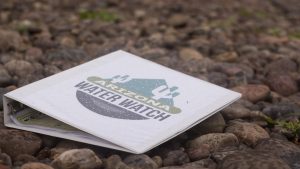- Slug: BC-CNS-Water Watch App. About 200 words
- Photos and captions below
- Video available here.
By NICOLE HERNANDEZ
Cronkite News
MESA – With a new mobile app, Arizonans can now help monitor and preserve the state’s lakes, streams and rivers.
The Water Watch App allows users to input observations about wildlife, pollution and water flow, snap a few photos and share the information with the Arizona Department of Water Quality, adding to the department’s understanding of the status of some of the state’s most precious natural resources.
“We compile data from all rivers, streams and lakes in Arizona, and then it rolls up into something called an assessment,” said Meghan Smart, citizen scientist coordinator and scientist at the water quality department. “We basically try and look at as many sites as we can per year to make sure (they are) healthy and environmentally sound and then try and identify pollution sources to fix.”
Monitoring the state’s bodies of waters is a time-consuming process, and enlisting the help of residents who already are out enjoying nature makes sense, she said.
“We have so many dedicated people in the state that are passionate. They care so much,” Smart said. “So if we can give them the tools to help protect and collect water quality data, it really helps our mission and does more good for the state.”
The app is available for phone or tablet and has a geolocation feature. It was developed as part of Arizona Water Watch, a program that aims to educate the public about water quality. That program also trains residents to be “citizen scientists” and sends them out to collect physical water samples.
Prescott resident Nicholas Balik volunteers as a citizen scientist for one of 20 groups across the state. The groups have between two and 20 people, and the participants range in age from 9 to almost 90. ADEQ scientists have trained them to test bodies of water for PH and temperature.
On a recent afternoon, Balik balanced on a rock in the middle of a river just west of Saguaro Lake in the East Valley. He demonstrated how to use the PH and temperature testing equipment by dipping a cylindrical device into the flowing water. The device connects back to a mobile phone, and it relays the information it picks up back to the scientist.
Balik said becoming a citizen scientist was “just another excuse to get out here.” Collecting water samples is a way to make the most of his time and serve his community while also enjoying nature.
“A lot of us love to hike, backpack, mountain bike,” he said. “When you’re out in those beautiful places, you can contribute. … You can actually provide long-term data that can be used to make better decisions on the management of our resources.”
Officials said you don’t have to receive training as a citizen scientist to use the app and collect information for the state.
To download the Water Watch App, go to Survey 123 and select “Open in the Survey123 field app.”
This story is part of Elemental: Covering Sustainability, a new multimedia collaboration between Cronkite News, Arizona PBS, KJZZ, KPCC, Rocky Mountain PBS and Southern California PBS.
For more stories from Cronkite News, visit cronkitenews.azpbs.org.
^_=


(Photo by Nicole Hernandez/Cronkite News)

